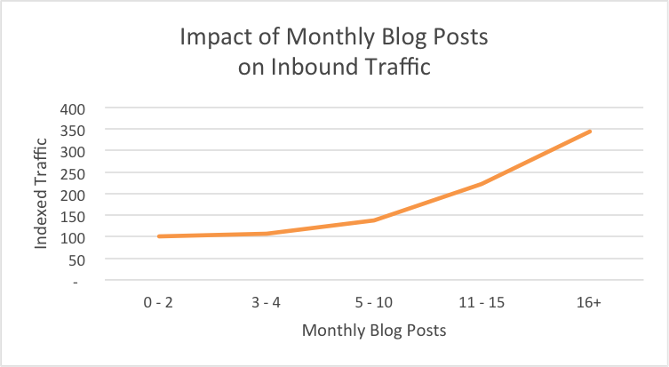
Last year, we did a pretty incredible internal study. And we found some pretty incredible results.
In our sample of over 10,000 keywords we monitored daily, we found that 91% of sites that held Page 1 Google rankings were sites that consistently created and shared content.
The results spoke for themselves, reiterating that played out but still true slogan: content is king.
Businesses that create and share content on a regular basis are reaping the benefits. This strategy encourages awareness and engagement, which in turn helps them earn top results in the coveted SERPs.
Content remains one of the undisputed core elements of a worthy SEO strategy.
The problem is, keeping up a steady stream of content just isn’t as easy as it looks. It’s not rocket science to write good content. But there is definitely an art to creating “great” content.
“If you want to stand out in an increasingly competitive online market, you need to create content that towers head and shoulders above the competition.” – Aaron Agius
So the question is, how do you go about making that shift?
Come with me… let’s find out together!
Pretend You’re a High School Student
Remember your 10th grade English teacher? You know, the one that was always nitpicking over the proper use of tense? The one that called you out in front of your friends for misspelling “acquiesce”?
She may no longer be in the room with you while you’re writing, but it might help your content if she were.
I’m Calling the Grammar Police!
It’s ok to be conversational and use colloquialisms in blog articles, but it’s not ok to forsake grammar and punctuation.
Following best writing practices while still maintaining your authentic voice can feel challenging at first. But trust me, it gets easier.
Like with all things in life, practice makes perfect. Be diligent and check your work before you publish it. It’s best if you can have someone else proof-read it as well, but this isn’t always possible in today’s fast-paced world.
In those scenarios, try using Grammarly.
It’s a nifty little tool that acts like MS Word spell check on steroids. Just try it, it’s free.
The only thing you have to lose is a little pride when it calls you out on a bunch of poor writing habits.
My Dog Ate My Content
If you’re going to write compelling content, you’re going to have to do some research.
Pulling ideas out of thin air is a great way to brainstorm. It’s not an effective way to build a thoughtful article.
In order to make sure your article is meaningful, original and accurate you’re going to have to present some data. In the age of the internet, anecdotal evidence isn’t worth a whole lot.
Keep Your Eyes on Your Own Paper
Plagiarism is bad. It always has been.
I don’t know about you, but I know I copied an occasional test answer back in the day. I was lucky (or careful) enough to not get caught, but I still learned my lesson the hard way.
After copying someone’s homework for a few weeks in calculus, I bombed a test. Surprise!
Incredibly irresponsible in retrospect, but I’m glad I learned the lesson then and there.
For those of you that may not have yet, let this serve as your warning. The penalties in adult life for plagiarizing are a bit more severe than those of our youth.
If you go around creating duplicate content and engaging in other unseemly behavior, Google’s going to hunt you down and slap you with a penalty before you even know what happened.
Please Wait, Scanning…
Surely you’ve heard all of that buzz about how readers typically only check out something between 20-28% of an article they click on?
Here’s the study that came up with these numbers. See what I did there? Research!
The point of the finding is that people want online content to be highly-scannable. If the text is packed in too densely they’ll just click back and move on.
In order to make your content scannable:
- Use lots of bullet lists
- Intersperse your article with bold and italic words.
- Use frequent and engaging headers
- Use an image roughly every 350 words (a Blog Pros study found this to be ideal)
Quality over Quantity
Balance is key. Like a jedi or a gymnast, you must master the art of balance.
How much content can you commit to putting out, while still maintaining a supremely high standard of quality?
This isn’t something you’re going to figure out right away. It’s going to take some time before you find what works for you.
It’s worth noting however, that there is a direct correlation between the number of blog posts a site publishes each month and the amount of traffic they garner from their articles.
What works for you will be highly dependent upon how much work you have to do outside of the content you’re trying to create. That’s also not to forget that promoting your work is a huge part of a successful content marketing strategy.
The key is to find a cadence that works for you. Once you’ve found that sweet spot, it’s just a matter of discipline. Stick to it, and the rewards will keep piling on.
If you find that you can’t keep up, outsourcing your content creation might be a good idea. We have our own blog management service that might be a good fit. If you’re curious, check it out!
Putting the Pieces Together
Transitioning your content marketing plan from good to great is quite literally a minefield. There are so many ways it can go wrong!
But don’t be afraid. If you focus on the basics we organized above, and if you do your research, you’ll be just fine. There are a ton of great resources out there for content creators nowadays.
So good luck and get to it!
















